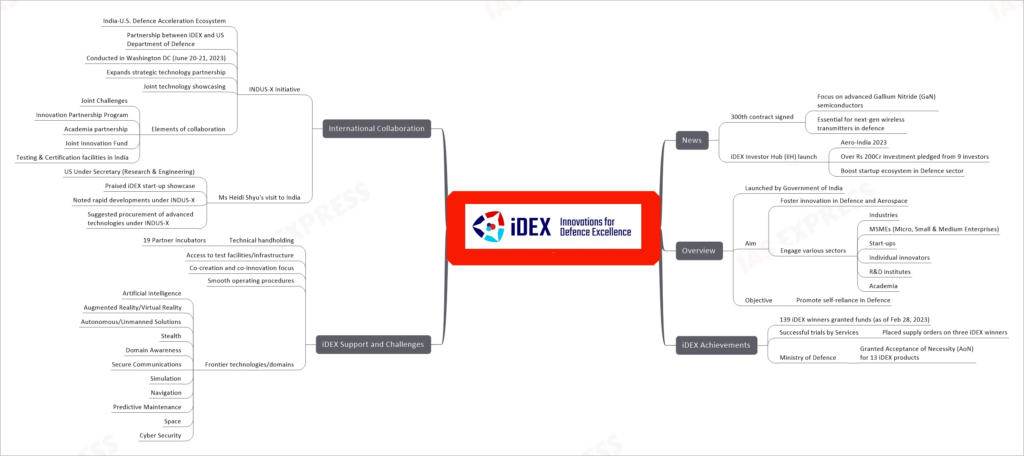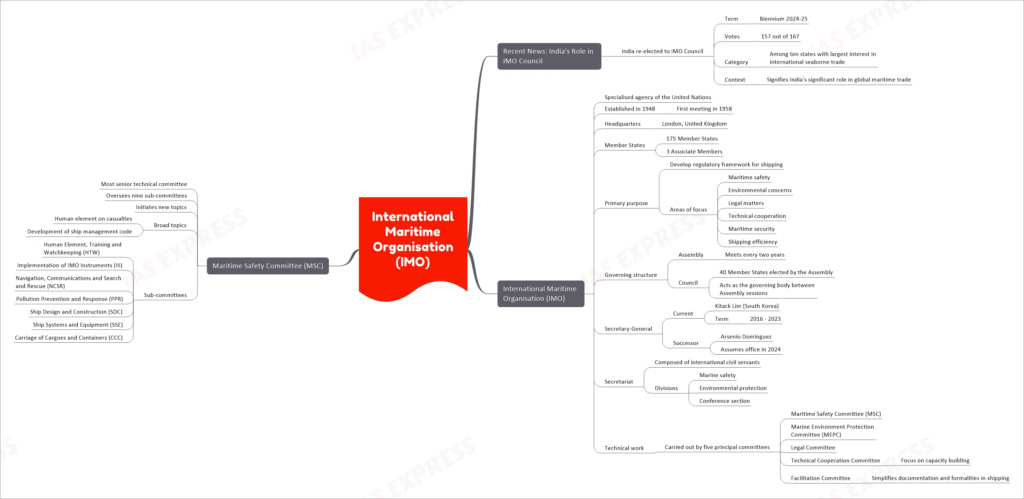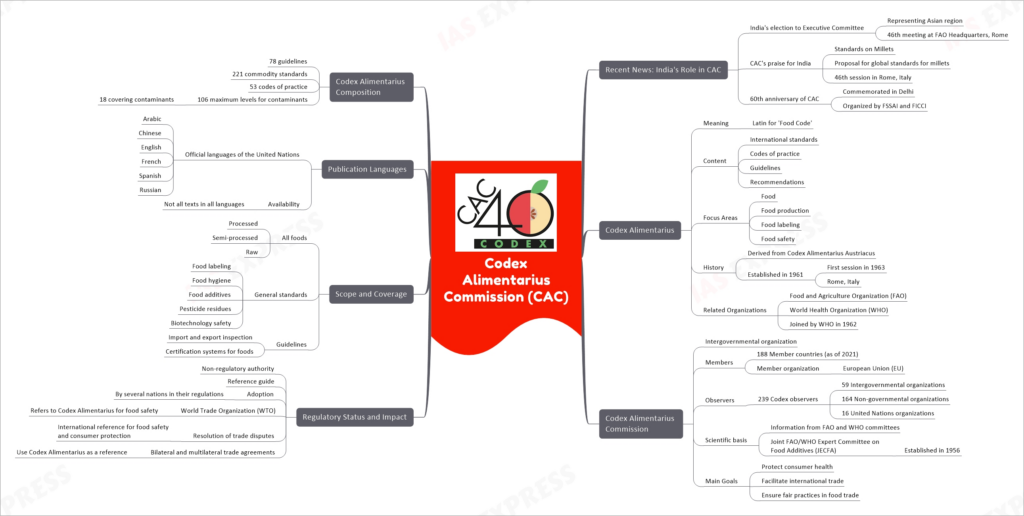[Newsbits] 3.12.2023 – International Maritime Organisation (IMO), Codex Alimentarius Commission (CAC) & more

This topic of “Innovations for Defence Excellence (iDEX)” is important from the perspective of the UPSC IAS Examination, which falls under General Studies Portion. In recent news, Innovations for Defence Excellence (iDEX) has marked significant milestones, including the signing of its 300th contract, with a particular focus on advanced Gallium Nitride (GaN) semiconductors, essential for next-generation wireless transmitters in the defense sector. Additionally, the launch of the iDEX Investor Hub (iIH) at Aero-India 2023, with over Rs 200 crore investment pledged from nine investors, aims to bolster the startup ecosystem in the defense sector. Innovations for Defence Excellence (iDEX), initiated by the Government of India, serves as a pivotal platform with a clear aim and objective: iDEX has already made significant strides in promoting innovation within the defense sector: To ensure its mission’s success, iDEX provides crucial support while facing specific challenges: iDEX’s reach extends beyond India’s borders through international collaboration: In conclusion, Innovations for Defence Excellence (iDEX) is making substantial contributions to the defense and aerospace sectors in India. With its achievements, support mechanisms, focus on frontier technologies, and international collaborations, iDEX is paving the way for innovative solutions that enhance the country’s self-reliance and technological prowess in defense. This topic of “International Maritime Organisation (IMO)” is important from the perspective of the UPSC IAS Examination, which falls under General Studies Portion. In recent news, India’s re-election to the International Maritime Organisation (IMO) Council for the biennium 2024-25 has underscored its substantial role in international seaborne trade. To delve into the significance of this event, we must first understand the core aspects of the IMO Council and its functions. The International Maritime Organisation, often referred to as IMO, stands as a specialized agency under the United Nations (UN) umbrella. Established in 1948, its inaugural meeting took place in 1958. IMO’s headquarters are situated in London, United Kingdom, and it boasts a membership of 175 Member States and 3 Associate Members. The primary purpose of the IMO is to develop a regulatory framework for shipping, addressing crucial areas such as: The IMO’s governing structure consists of two significant bodies: The Secretary-General of the IMO is responsible for its administration. The current Secretary-General is Kitack Lim from South Korea, serving from 2016 to 2023. His successor, Arsenio Dominguez, will assume office in 2024. The IMO Secretariat is composed of international civil servants and is organized into various divisions, including: Technical work within the IMO is carried out by five principal committees: The Maritime Safety Committee (MSC) holds the distinction of being the most senior technical committee within the IMO. It has oversight of nine sub-committees and is responsible for initiating new topics related to maritime safety. Some of the broad topics it addresses include the human element on casualties and the development of the ship management code. The MSC oversees the following sub-committees: India’s re-election to the IMO Council for the biennium 2024-25 is a noteworthy event in the maritime world. This achievement highlights India’s prominent role in global maritime trade. Here are some key details: India’s re-election to the IMO Council serves as a testament to its growing prominence in the realm of international maritime trade and safety. As a key player within the IMO, India’s role in shaping the future of global shipping regulations and standards is set to become even more pronounced in the coming years. This topic of “Codex Alimentarius Commission (CAC)” is important from the perspective of the UPSC IAS Examination, which falls under General Studies Portion. In a recent development, India has played a notable role in the Codex Alimentarius Commission (CAC). India’s active participation and contributions to CAC’s initiatives highlight the nation’s growing influence in the global food regulatory landscape. Noteworthy events include India’s election to the Executive Committee, CAC’s recognition of India’s standards on millets, and the commemoration of CAC’s 60th anniversary in Delhi. The term “Codex Alimentarius” originates from Latin, translating to the ‘Food Code.’ It represents a comprehensive set of international standards, codes of practice, guidelines, and recommendations relating to various aspects of the food industry. Codex Alimentarius encompasses a wide range of content, including: The primary focus areas of Codex Alimentarius include: The roots of Codex Alimentarius can be traced back to the Codex Alimentarius Austriacus. It was officially established in 1961, with its inaugural session taking place in 1963 in Rome, Italy. Codex Alimentarius Commission collaborates closely with various international bodies, including: The Codex Alimentarius Commission operates with several primary objectives: The Codex Alimentarius Commission functions as an intergovernmental organization with a broad membership base. As of 2021, the commission comprises 188 member countries. Additionally, the European Union (EU) is recognized as a member organization. The commission also welcomes observers from various sectors: The scientific foundation of the Codex Alimentarius Commission is built upon information derived from FAO and WHO committees. One notable committee is the Joint FAO/WHO Expert Committee on Food Additives (JECFA), established in 1956. Despite being a non-regulatory authority, the Codex Alimentarius Commission wields considerable influence in the realm of international food standards and safety. Codex Alimentarius has a comprehensive scope, encompassing all types of foods, whether processed, semi-processed, or raw. It offers general standards and guidelines across various domains, including: Additionally, Codex Alimentarius provides guidelines for import and export inspection and certification systems for foods. To ensure global accessibility, Codex Alimentarius materials are available in the official languages of the United Nations: However, not all texts are available in all languages, highlighting the complexity of the content. The Codex Alimentarius is a vast compilation of standards and guidelines, including: In conclusion, the Codex Alimentarius Commission, with its rich history and extensive reach, plays a pivotal role in shaping global food standards and safety regulations. Its collaborative efforts with international organizations, diverse membership base, and comprehensive content make it an indispensable entity in the realm of food safety and trade. India’s recent involvement and contributions underscore the evolving dynamics of this influential commission, as it continues to safeguard consumer health and promote fair practices in the global food industry.Introduction
Overview
iDEX Achievements
iDEX Support and Challenges
International Collaboration
Introduction
International Maritime Organisation (IMO)
Purpose and Focus
Governing Structure
Leadership
Secretariat
Technical Work
Maritime Safety Committee (MSC)
Sub-committees
Recent News: India’s Role in IMO Council
Conclusion
Introduction
Codex Alimentarius
Meaning
Content
Focus Areas
History
Related Organizations
Commission’s Main Goals
Codex Alimentarius Commission
Members
Observers
Scientific Basis
Regulatory Status and Impact
Scope and Coverage
Publication Languages
Codex Alimentarius Composition
Conclusion



